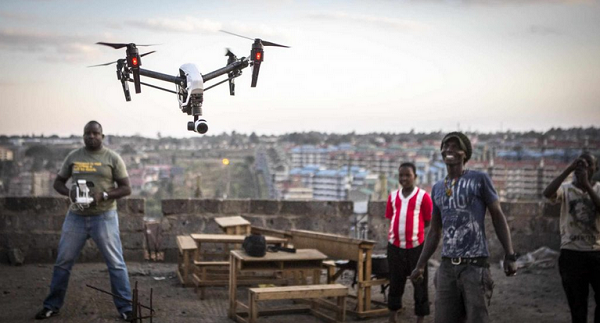Cheap imported drones – a contributing factor to the rising number of deaths in Africa
When they hear an ominous buzz that sounds like a swarm of angry bees, the people of northern Ethiopia run for cover. They know a drone attack is beginning again.
But for the villagers who were travelling home from a child’s baptism in late February, there was no time to hide. A missile from a drone hit their pick-up truck and obliterated it. At least 30 people were killed, and dozens were injured.
“We don’t understand what our families did to be targeted,” said Wolde, a farm worker who lost seven relatives in the attack in Ethiopia’s Amhara region. “The war front is 20 kilometres away, and there are no fighters in our area.”
Across Africa, a flood of cheap imported drones is changing the face of warfare, making it deadlier and more indiscriminate. The proliferation of easy-to-obtain drones – known as unmanned aerial vehicles (UAVs) – is fuelling conflicts, increasing civilian casualties and filling the skies with new dangers.
Schools, markets, weddings, funerals and civilian vehicles have all been hit by poorly targeted drone strikes, usually with little explanation, or later acknowledged as mistakes. By some estimates, thousands of African civilians have been killed by UAVs in the past three years.
African armies and rebel militias see the drones as a highly useful and attractive asset. Most drones can fly for 12 to 24 hours, at speeds of 200 kilometres an hour, carrying an arsenal of laser-guided bombs and rockets.
They can be imported for as little as US$1-million each, making them far cheaper than any warplane. They are often eagerly supplied by authoritarian states, including Iran and China, which are keen to build their political influence in African countries.
Fear and intimidation are among their main weapons. In the Amhara attack, the military drone returned to the site of the deaths, hovering nearby and forcing emergency workers to flee repeatedly as they tried to collect the bodies.
“Some of us are afraid to gather in groups now because our loved ones were in a group when they were killed,” Wolde said. (The Globe and Mail is identifying local residents only by first names because they risk retribution for commenting.)
More than 20 African armies – and some rebel groups – are believed to be using drones today. In recent months, in almost every African war zone, drones have taken an increasingly prominent role. But civilians are often the ones who pay the human toll.
In the devastating war that began in Sudan last year, the Sudanese army is making extensive use of Iranian-made Mohajer-6 drones to attack its rival, the paramilitary Rapid Support Forces (RSF). These strikes have often inflicted injuries on civilians, according to local media. The RSF, for its part, is reportedly deploying Chinese-made drones to attack Sudanese military positions.
In Mali, the military and its allied Russian forces have acquired Turkish-made Bayraktar TB2 drones, each of which can fire up to four laser-guided bombs. Two drone strikes killed at least 13 civilians, including several children, at a wedding and a funeral in northern Mali in February, according to human-rights groups. Two more drone strikes in March killed at least 13 civilians, including seven children, Amnesty International reported.
In Burkina Faso, the national army deployed Turkish-made UAVs in three strikes that killed at least 60 civilians at a funeral and two crowded markets between August and November of last year, Human Rights Watch said. “The drone strikes violated laws-of-war prohibitions against attacks that do not discriminate between civilians and military targets and were apparent war crimes,” it said in a report in January.
In northern Nigeria, a military drone strike killed 85 civilians at a religious celebration in early December, apparently in an attempt to hit a criminal gang. The military later apologized, calling it a mistake.
In Somalia, the Turkish military has been carrying out its own drone strikes to help the national army in its battles against al-Shabaab, an Islamist rebel militia. More than 20 Somali civilians were killed in a Turkish drone strike near the capital, Mogadishu, on March 19, local media reported. The United States has deployed its own drones in Somalia for years, sometimes inflicting civilian casualties during its air strikes.
In the Democratic Republic of the Congo, the national military has acquired drones from China for its battle against the M23 rebel militia, while M23 in turn has obtained its own drones. Libya has purchased drones from Turkey, and Uganda has built a drone-making factory with Chinese help.
Ethiopia is perhaps the country where drones have inflicted the most horrific damage. The government has been importing Chinese and Turkish drones for years, deploying them extensively in its battle from 2020 to 2022 against Tigrayan forces in northern Ethiopia.
Hundreds of civilians were reportedly killed by Ethiopian military drones in the Tigray war, and hundreds more have been killed since then in the Amhara and Oromia regions. Rebel militias are the official target, but the military seems to have impunity for indiscriminate attacks that often kill civilians, human-rights activists say.
In the town of Wegel Tena, in the Amhara region, five people were killed when a drone hit an ambulance last November. Since then, drones have continued to buzz in the skies over the town.
“They cause great anxiety, because everyone knows the bloodshed they cause,” said Henok, a shop owner in the town.
“It’s easy to flee from war because you know when the fighting is approaching,” he said. “But you can never know when the drones will bomb you.”
This article was first reported by The Globe and Mail












